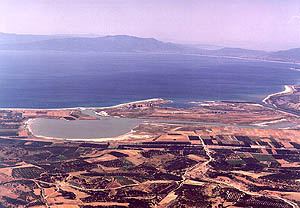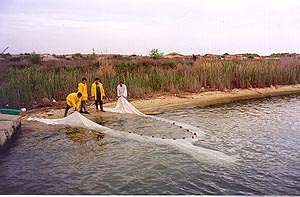|
WHO Co-ordinating body or lead partner of ICZM process or project (with a short description) |
Fisheries Research Institute (research institute that belongs to the Greek National Agricultural Research Foundation, a research foundation supervised by the Greek Ministry of Agriculture). |
|
WHERE Location (community, province, country) |
Strymonikos and Ierissos Gulfs, that belongs to 4 prefectures (Kavala, Serres, Thessaloniki, Chalkidiki). The Kavala and Serres Prefectures belong to the East Macedonia & Thrace Region and the Thessaloniki and Chalkidiki Prefectures belong to the Central Macedonia Region, Greece. |
 View of the Strymon estuarine system (photo: Koutrakis E.) |
|
|
WHEN When did the process start? Is it ongoing? |
1.1.1997 and it is ended on 31.4.2000 (only the Information Centre continues to operate funded by the local municipality) |
|
HOW Who funded and/or initiated it? Is it part of a programme? |
Co-funded
by the LIFE funding instrument (E.E., DG XI, 50%) and the Greek Ministries
of Environment (20%) and Agriculture (30%). |
|
MAIN ISSUES What are the key issues, the main problems or conflicts? |
Human
activities in the area include mass tourism, uncontrolled building,
fisheries, aquaculture, agriculture, forestry and mineral extraction.
These activities are not always practised wisely leading to increasing
environmental problems, such as pollution and landscape deterioration,
which will become by far more serious in the next decades, as a result
of the expected increase of tourists from the Eastern European countries.
Also, mining activities in Chalkidiki are changing and an industry
for gold extraction is going to be created in the area, posing additional
threats to the environment. The Egnatia highway which will connect
the Ionian Sea with Asia is now under construction. Finally, it must
be considered that River Strymon may carry pollutants from its Bulgarian
and Greek watershed into Strymonikos Gulf. The main problems for implementing ICZM in the area were: In order to cope with the above problems the following tasks were organised in the project:
|
 Fish sampling: Sampling in the estuarine system of the Strymon river in order to record the fish abundance in the area (photo: Koutrakis E.) |
|
|
PROGRESS & CONTINUETY Is the project / process having a follow up. If not: when did the progress stop and what the main reason was? |
The project
has ended at 30/4/2000 as it was appointed (36 months + 4 months
extension). |
|
LESSONS LEARNT What sort of lessons can be learnt from this example? Characterise briefly |
The good
knowledge of the environmental, social, economic and administrative
features of the area to be managed is the first essential step in
planning integrated management and sustainable development, while
continuous monitoring is necessary to detect environmental changes.
|
|
FURTHER INFORMATION Who can provide further information with contacts? |
Dr. Emmanuil
KOUTRAKIS and Dr. Thalia
Lazaridou |